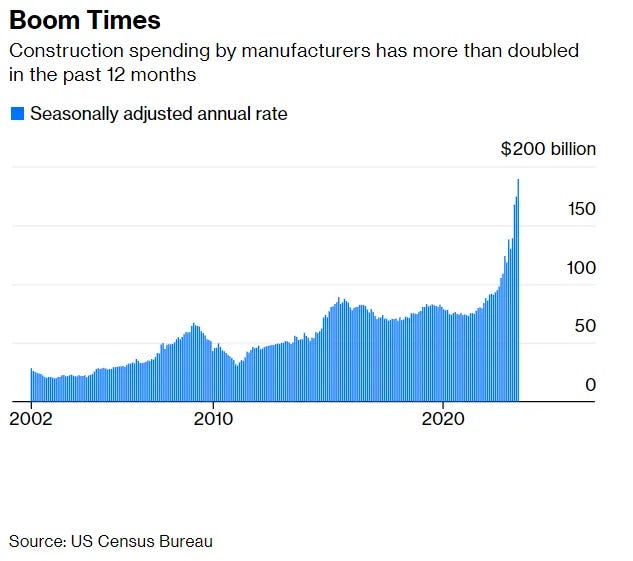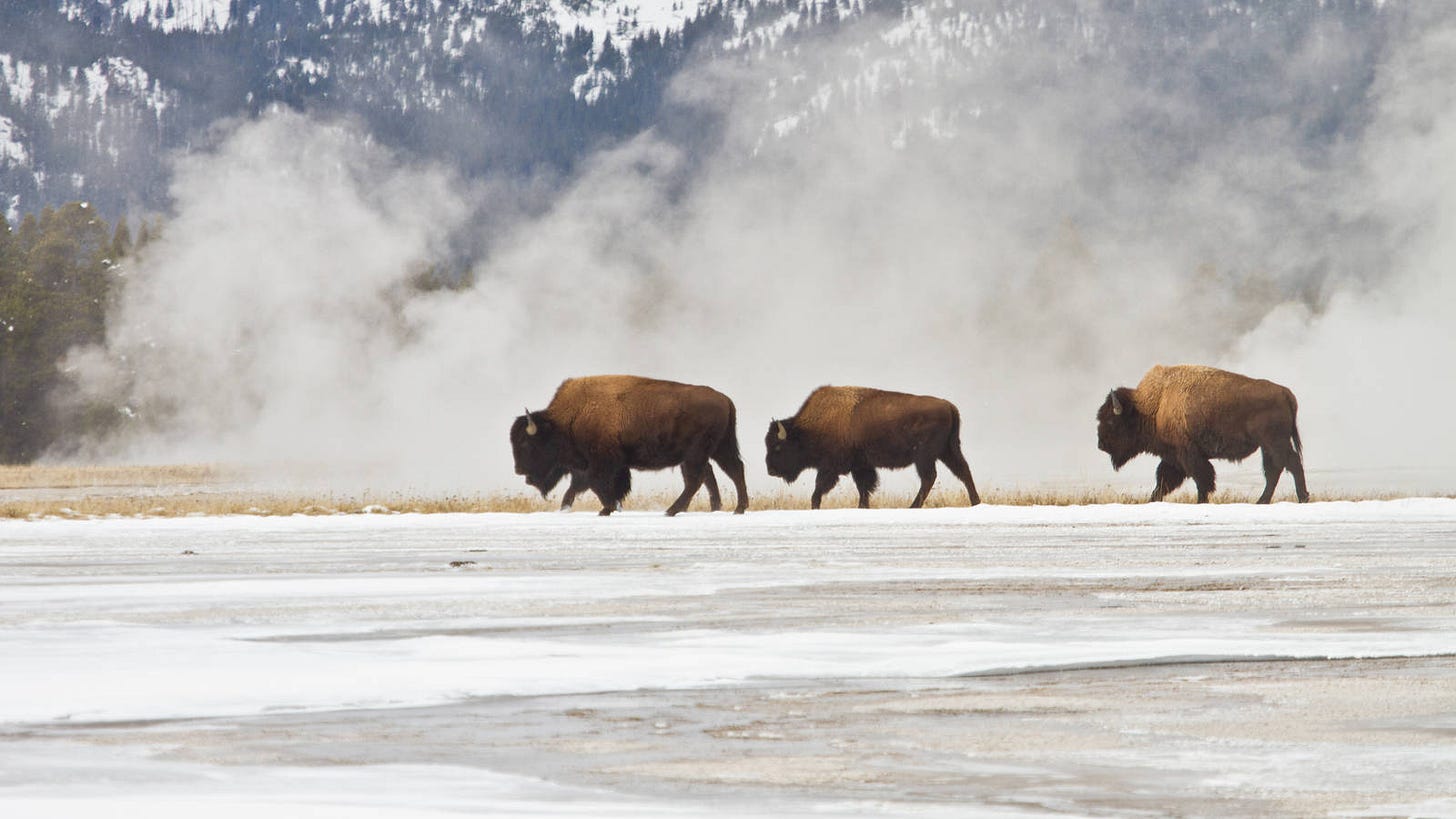The Weekly Anthropocene, July 5 2023
Happy Fourth of July! Here's a recap of some of the epic American progress on clean energy and conservation in the last year.
United States of America: The Biden Boom
On this Fourth of July, it’s worth taking a moment to celebrate the extraordinary progress America has made since its last Independence Day. In particular, there has still been not nearly enough media coverage of the epic, historic victory that is the Inflation Reduction Act (IRA) of August 2022, and its unleashing of an unprecedented American clean energy boom. Here’s a recap of some of the major news items from the last few months.
The Inflation Reduction Act has fueled an economy-reshaping boom in American clean energy manufacturing, with an associated jobs surge. As Bloomberg reports (see chart), construction spending by manufacturers in the United States more than doubled between June 2022 and June 2023.
Just under $80 billion in investment across nearly 100 new American clean energy manufacturing projects was announced between the IRA signing in August 2022 and the end of May 2023, mostly for solar panel, battery, and EV plants.
Much of this is in a new Eastern “battery belt” region stretching from Michigan to Georgia, revitalizing historic manufacturing communities. Notably, the five key swing states of Georgia, Michigan, Nevada, North Carolina, and Arizona have each received over $1 billion in new EV supply chain investments.
American lithium-ion battery manufacturing is on track to grow tenfold by 2027.
One company, South Korea’s LG, is responsible for quite a lot of the new battery factories in the above map, partnering with American companies including GM in plans to build nearly 280 gigawatt-hours’ worth of battery-making capacity across factories in Georgia, Ohio, Michigan, Tennessee, and Arizona.
Wind turbine manufacturing in the US is making a comeback as well, after a downturn in recent years as many companies moved to countries with lower labor costs.
And displaced coal miners are finding new jobs in clean energy manufacturing, with one battery plant in West Virginia committing to hire UMWA union miners for the vast majority of jobs.
A new report from Dartmouth, Princeton, and the BlueGreen Alliance has calculated that thanks to the IRA (specifically the 45X MPTC tax credit for clean manufacturing), it will shortly be cheaper for American energy projects to use American-made solar and wind components than imported solar and wind components. Once the huge wave of new solar panel factories currently in the pipeline are built, they estimate that completely US-made solar panels will be 30% cheaper than imported solar panels.
And even before the IRA, clean energy in the USA was on a roll. The US Energy Information Administration (EIA) calculates that 84% of new electricity-producing capacity set to come online in the United States in 2023 will be from clean energy, with solar, battery storage, wind, and a tiny bit of nuclear all contributing carbon-free power! That’s up from 78% clean energy in new power capacity built in 2022.
This only counts the projects that the EIA expects will come online and start generating electricity this year. There are lots and lots more renewables projects in the pipeline (in fact, enough proposals to replace all of America’s current electricity generating capacity!), but the ones listed for 2023 are the ones that have made it through the labyrinth of grid interconnection problems, permitting issues, and construction supply chain woes to be confidently listed as nearing completion.
Keep in mind as well that these projects set to finish in 2023 had all made it through major investment decisions before the Inflation Reduction Act was passed in August 2022. Future renewables projects will be substantially cheaper and more financially attractive thanks to new federal funding.
And summing up all this: a new analysis from the National Renewable Energy Laboratory forecasts that the Bipartisan Infrastructure Law of 2021 (BIL) and the Inflation Reduction Act of 2022 (IRA) are set to deliver immense, far-reaching shifts in the American power sector1, boosting renewables and reducing emissions and health risks much more than the previously expected pathway.
Here’s the full report, and a Department of Energy fact sheet with an awesome summary graphic. Key stats:
Their “mid-case scenario” prediction is that the US grid will have about 81% carbon-free electricity in 2030 (up from 41% in 2022, including solar, wind, hydro, and nuclear). This could be much as “best case” 90% clean electricity by 2030 if technology costs drop faster than expected, or a still-respectable “worst case” 71% clean electricity by 2030 if grid interconnection issues take a toll. Before these bills passed, the NREL expected about 52% clean electricity by 2030.
In their mid-case scenario, the NREL also expects power sector carbon dioxide emissions to decline by 84% below 2005 levels by 2030!
And the replacement of fossil fuels will bring substantial health benefits as well due to reduced air pollution: the NREL expects the IRA and BIL to save 11,000-18,000 lives by 2030!
Since this writer was a small child, rafts of books and reams of policy papers have been produced bemoaning the decline of American manufacturing, and the need to build it up again to help decarbonize the economy and power a clean energy future. And now, seemingly unnoticed by the general public, we’re just going ahead and doing it. The Biden Administration’s deft political leadership to get the IRA passed (and the BIL before it) has unleashed American ingenuity and entrepreneurship in the service of decarbonizing our economy and finally replacing the fossil fuel industry, the root cause of worst public health and ecological threats of our time. This Fourth of July, the Inflation Reduction Act and the Biden Boom in clean energy make me proud to be an American.
American Bison
As previously reported in March 2023, the Biden Administration’s Interior Department will be using $25 million in Inflation Reduction Act funds to boost bison conservation across America, managed by a new Bison Working Group and Bison Management Apprenticeship program. The funds will be used to establish new bison herds, support prescribed-fire efforts to maintain grassland ecosystems, and support the transfer of American bison to Native American tribal lands.
This is an extraordinary culmination to a historic decades-long reversal in American bison policy, from genocidal slaughter to strong and moral conservation efforts. In the mid-1800s, the US government killed as many bison as possible with the express intent of depriving Plains Native Americans of their livelihoods. Now, under the Biden Administration and the first Native American Interior Secretary, the United States is finally working to give bison back to its Native American citizens!
“The rapid disappearance of the game [bison] from the former hunting-grounds must operate largely in favor of our efforts to confine the Indians to smaller areas, and compel them to abandon their nomadic customs.”
-Secretary of the Interior Columbus Delano, a white man, 1872
“While the overall recovery of bison over the last 130 years is a conservation success story, significant work remains to…provide for the return of bison to Tribally owned and ancestral lands. New historic funding from the Inflation Reduction Act will help support the Department’s efforts to restore this iconic species and integrate Indigenous Knowledge into our shared stewardship goals.”
-Secretary of the Interior Deb Haaland, a Native American woman, 2023
American Forests
In 2022, federal funds from the Forest Legacy Program helped make possible the Quill Hill to Perham Stream conservation project in this writer’s home state of Maine (pictured), using both state purchases and conservation easements on private property to conserve 13,000 acres of forest land the public to enjoy.
At a recent event in Rangeley, Maine to celebrate this project, the US Forest Service announced that the Forest Legacy Program, bolstered by new funds from the Inflation Reduction Act and Land and Water Conservation Fund, is planning to conserve 245,000 acres of particularly significant forest lands across the nation in the upcoming years. That’s over 380 square miles, an area larger than New York City. They’re starting with a $188 million investment in 34 new forest conservation projects across 23 states and territories. (Here’s an interactive map of the program’s past and upcoming projects). It’s forgotten amid the clean energy bonanza, but the IRA and BIL were substantial landscape conservation bills as well!
Hawaiian Birds


Many Biden Administration conservation projects are supported by the Department of the Interior’s new Restoration and Resilience Framework, funded by $2 billion in BIL and IRA money. On June 27, 2023, Secretary Haaland announced that the Framework will commit nearly $16 million to support a new Hawaiian Forest Bird Conservation Keystone Initiative. The funds will be dedicated to captive care, research and monitoring, eradicating the invasive mosquitoes spreading avian malaria (a problem made worse by climate change warming forests and expanding the mosquitoes’ range), and other actions to save Hawaii’s highly imperiled forest bird species.
This is a tiny amount of money compared to the Administration’s epic clean energy investments, but it may well make enough of a difference to keep Hawaii’s living jewels alive in the Anthropocene. A recent report found that four critically endangered species of Hawaiian honeycreeper, including the ‘akikiki, ‘akeke‘e, kiwikiu (pictured, top right), and ākohekohe (pictured, top left), are at imminent risk of extinction within the next few years. They now have a fighting chance.
Note: this recap has focused primarily the manufacturing side of the IRA, because that’s been an area where America has underinvested in recent decades and where we’re now seeing a particularly dramatic turnaround. But there’s so much more: the IRA also directly funds clean energy deployment, from utility-scale solar and wind projects to household-scale rooftop solar, clean appliances, and electric cars. The Department of Energy has created a new Energy Savings Hub, at energy.gov/save, to guide Americans through accessing the Inflation Reduction Act’s bonanza of individual-level clean energy tax credits. If you’re a US taxpayer, check it out to claim your share of federal clean energy incentives! In my day job, I cowrote a guide on this for Maine residents.










The Infrastructure act will be studied by future generations in the same way the New Deal was, I think. This is paving the way for our future survival, and this investment is absolutely necessary on so many levels.